A Complete Meteo/Hydro/Hydraulic Chain Application to Support Early Warning and Monitoring Systems: The Apollo Medicane Use Case
Abstract
1. Introduction
- Data download and storage services: Supporting the modeling and observational data stream for the subsequent modeling instances.
- Meteorological forecasts: The WRF meteorological model, executed on High-Performance Computing (HPC) facilities, provides high-resolution weather forecasts after the assimilation of radar reflectivity and weather station observations.
- Hydrological forecast: The fully distributed hydrological model Continuum, executed on cloud computing facilities, provides the peak discharge forecast based on the WRF meteorological input and assimilated Sentinel 1 soil moisture products.
- Flooded area detection: The automatic system for water detection (AUTOWADE) exploits satellite acquisitions, along with ad hoc tasks set depending on the meteorological forecasts (Sentinel 1 and COSMO SKYMED) to operationally monitor the flooded areas.
- Hydraulic forecast: The TELEMAC-2D hydraulic model, executed on HPC facilities, integrates Continuum forecasts to predict flooded areas.
2. Materials and Methods
2.1. Case Study Description: The Apollo Medicane
2.2. The Meteorological Model: WRF
2.3. The Hydrological Modeling Chain: Flood-PROOFS
2.4. The Automatic System for Water Detection: AUTOWADE
2.5. The Floodwater Depth Estimation Tool: FwDET
2.6. The Hydraulic Model: TELEMAC-2D
3. Results and Discussion
3.1. The Operational Meteorological Forecast
3.2. The Hydrological Forecast
3.3. The Hydrological Monitoring
3.4. Flood Mapping with 2D Hydraulic Model
3.5. Flood Mapping from Satellites
- S1—25 October 2021 at 17.00 UTC
- CSK—27 October 2021 at 16.45.
- CSK—28 October 2021 at 16.45.
- CSG 2nd generation—30 October 2021 at 04.30.
- S1—31 October 2021 at 05.00 UTC.
3.6. Flood Depth Estimation with FwDET
3.7. Hindcast Experiments to Improve the Forecasting Chain
4. Concluding Remarks
Author Contributions
Funding
Data Availability Statement
Acknowledgments
Conflicts of Interest
References
- Emanuel, K. Genesis and maintenance of “Mediterranean hurricanes”. Adv. Geosci. 2005, 2, 217–220. [Google Scholar] [CrossRef]
- Romero, R.; Emanuel, K. Medicane risk in a changing climate. J. Geophys. Res. Atmos. 2013, 118, 5992–6001. [Google Scholar] [CrossRef]
- Cavicchia, L.; von Storch, H.; Gualdi, S. A long-term climatology of medicanes. Clim. Dyn. 2014, 43, 1183–1195. [Google Scholar] [CrossRef]
- Cioni, G.; Malguzzi, P.; Buzzi, A. Thermal structure and dynamical precursor of a Mediterranean tropical-like cyclone. Q. J. R. Meteorol. Soc. 2016, 142, 1757–1766. [Google Scholar] [CrossRef]
- Molini, L.; Parodi, A.; Rebora, N.; Craig, G.C. Classifying severe rainfall events over Italy by hydrometeorological and dynamical criteria. Quart. J. Roy. Meteor. Soc. 2011, 137, 148–154. [Google Scholar] [CrossRef]
- Department, I.C.P.; Foundation, C.R. The Dewetra platform: A multi-perspective architecture for risk management during emergencies. In Proceedings of the Information Systems for Crisis Response and Management in Mediterranean Countries: First International Conference, ISCRAM-med 2014, Toulouse, France, 15–17 October 2014; Proceedings 1. Springer: Berlin/Heidelberg, Germany, 2014; pp. 165–177. [Google Scholar]
- Longhitano, S.; Colella, A. Geomorphology, sedimentology and recent evolution of the anthropogenically modified Simeto River delta system (eastern Sicily, Italy). Sediment. Geol. 2007, 194, 195–221. [Google Scholar] [CrossRef]
- Longhitano, S.; Colella, A. Stratigraphy and basin-fill architecture of the Plio-Pleistocene Catania Plain foredeep basin (eastern Sicily): A preliminary synthesis. GeoActa 2003, 1, 75–89. [Google Scholar]
- Skamarock, W.C.; Klemp, J.B.; Dudhia, J.; Gill, D.O.; Barker, D.M.; Duda, M.; Wang, X.Y.; Wang, W.; Power, J.G. A Description of the Advanced Research WRF Version 3 (No. NCAR/TN-475+STR); University Corporation for Atmospheric Research: Boulder, CO, USA, 2008. [Google Scholar] [CrossRef]
- Fiori, E.; Ferraris, L.; Molini, L.; Siccardi, F.; Kranzlmueller, D.; Parodi, A. Triggering and evolution of a deep convective system in the Mediterranean sea: Modelling and observations at a very fine scale. Quart. J. Roy. Meteor. Soc. 2017, 143, 927–941. [Google Scholar] [CrossRef]
- Lagasio, M.; Parodi, A.; Procopio, R.; Rachidi, F.; Fiori, E. Lightning potential index performances in multimicrophysical cloud-resolving simulations of a back-building mesoscale convective system: The Genoa 2014 event. J. Geophys. Res. Atmos. 2017, 122, 4238–4257. [Google Scholar] [CrossRef]
- Lagasio, M.; Silvestro, F.; Campo, L.; Parodi, A. Predictive capability of a high-resolution hydrometeorological forecasting framework coupling WRF cycling 3dvar and Continuum. J. Hydrometeorol. 2019, 20, 1307–1337. [Google Scholar] [CrossRef]
- Paulson, C.A. The mathematical representation of wind speed and temperature profiles in the unstable atmospheric surface layer. J. Appl. Meteor. 1970, 9, 857–860. [Google Scholar] [CrossRef]
- Dyer, A.J.; Hicks, B.B. Flux-gradient relationships in the constant flux layer. Quart. J. Roy. Meteor. Soc. 1970, 96, 715–721. [Google Scholar] [CrossRef]
- Webb, E.K. Profile relationships: The log-linear range, and extension to strong stability. Quart. J. Roy. Meteor. Soc. 1970, 96, 67–90. [Google Scholar] [CrossRef]
- Beljaars, A.C. The parametrization of surface fluxes in large-scale models under free convection. Quart. J. Roy. Meteor. Soc. 1995, 121, 255–270. [Google Scholar] [CrossRef]
- Smirnova, T.G.; Brown, J.M.; Benjamin, S.G. Performance of different soil model configurations in simulating ground surface temperature and surface fluxes. Mon. Wea. Rev. 1997, 125, 1870–1884. [Google Scholar] [CrossRef]
- Smirnova, T.G.; Brown, J.M.; Benjamin, S.G.; Kim, D. Parameterization of cold season processes in the MAPS land-surface scheme. J. Geophys. Res. 2000, 105, 4077–4086. [Google Scholar] [CrossRef]
- Hong, S.Y.; Noh, Y.; Dudhia, J. A new vertical diffusion package with an explicit treatment of entrainment processes. Mon. Wea. Rev. 2006, 134, 2318–2341. [Google Scholar] [CrossRef]
- Hong, S.Y.; Lim, J.O.J. The WRF single-moment 6-class microphysics scheme (WSM6). Asia-Pac. J. Atmos. Sci. 2006, 42, 129–151. [Google Scholar]
- Iacono, M.J.; Delamere, J.S.; Mlawer, E.J.; Shephard, M.W.; Clough, S.A.; Collins, W.D. Radiative forcing by long-lived greenhouse gases: Calculations with the AER radiative transfer models. J. Geophys. Res. Atmos. 2008, 113, D13103. [Google Scholar] [CrossRef]
- Wang, H.; Huang, X.Y.; Sun, J.; Xu, D.; Zhang, M.; Fan, S.; Zhong, J. Inhomogeneous background error modeling for WRF-Var using the NMC method. J. Appl. Meteor. Climatol. 2014, 53, 2287–2309. [Google Scholar] [CrossRef]
- Silvestro, F.; Gabellani, S.; Delogu, F.; Rudari, R.; Boni, G. Exploiting remote sensing land surface temperature in distributed hydrological modelling: The example of the Continuum model. Hydrol. Earth Syst. Sci. 2013, 17, 39–62. [Google Scholar] [CrossRef]
- Silvestro, F.; Gabellani, S.; Rudari, R.; Delogu, F.; Laiolo, P.; Boni, G. Uncertainty reduction and parameter estimation of a distributed hydrological model with ground and remote-sensing data. Hydrol. Earth Syst. Sci. 2015, 19, 1727–1751. [Google Scholar] [CrossRef]
- Bruno, G.; Pignone, F.; Silvestro, F.; Gabellani, S.; Schiavi, F.; Rebora, N.; Giordano, P.; Falzacappa, M. Performing Hydrological Monitoring at a National Scale by Exploiting Rain-Gauge and Radar Networks: The Italian Case. Atmosphere 2021, 12, 771. [Google Scholar] [CrossRef]
- Laiolo, P.; Gabellani, S.; Campo, L.; Silvestro, F.; Delogu, F.; Rudari, R.; Pulvirenti, L.; Boni, G.; Fascetti, F.; Pierdicca, N.; et al. Impact of different satellite soil moisture products on the predictions of a continuous distributed hydrological model. Int. J. Appl. Earth Obs. Geoinf. 2016, 48, 131–145. [Google Scholar] [CrossRef]
- Cenci, L.; Laiolo, P.; Gabellani, S.; Campo, L.; Silvestro, F.; Delogu, F.; Boni, G.; Rudari, R. Assimilation of H-SAF soil moisture products for flash flood early warning systems. Case study: Mediterranean catchments. IEEE J. Sel. Top. Appl. Earth Obs. Remote. Sens. 2016, 9, 5634–5646. [Google Scholar] [CrossRef]
- Cenci, L.; Pulvirenti, L.; Boni, G.; Chini, M.; Matgen, P.; Gabellani, S.; Squicciarino, G.; Pierdicca, N. An evaluation of the potential of Sentinel 1 for improving flash flood predictions via soil moisture–data assimilation. Adv. Geosci. 2017, 44, 89–100. [Google Scholar] [CrossRef]
- Corral, C.; Berenguer, M.; Sempere-Torres, D.; Poletti, L.; Silvestro, F.; Rebora, N. Comparison of two early warning systems for regional flash flood hazard forecasting. J. Hydrol. 2019, 572, 603–619. [Google Scholar] [CrossRef]
- Poletti, M.L.; Silvestro, F.; Davolio, S.; Pignone, F.; Rebora, N. Using nowcasting technique and data assimilation in a meteorological model to improve very short range hydrological forecasts. Hydrol. Earth Syst. Sci. 2019, 23, 3823–3841. [Google Scholar] [CrossRef]
- Alfieri, L.; Avanzi, F.; Delogu, F.; Gabellani, S.; Bruno, G.; Campo, L.; Libertino, A.; Massari, C.; Tarpanelli, A.; Rains, D.; et al. High resolution satellite products improve hydrological modeling in northern Italy. Hydrol. Earth Syst. Sci. Discuss. 2022, 26, 3921–3939. [Google Scholar] [CrossRef]
- Pulvirenti, L.; Squicciarino, G.; Fiori, E.; Ferraris, L.; Puca, S. A Tool for Pre-Operational Daily Mapping of Floods and Per-Manent Water Using Sentinel-1 Data. Remote. Sens. 2021, 13, 1342. [Google Scholar] [CrossRef]
- Cohen, S.; Raney, A.; Munasinghe, D.; Loftis, J.D.; Molthan, A.; Bell, J.; Rogers, L.; Galantowicz, J.; Brakenridge, G.R.; Kettner, A.J.; et al. The Floodwater Depth Estimation Tool (FwDET v2. 0) for improved remote sensing analysis of coastal flooding. Nat. Hazards Earth Syst. Sci. 2019, 19, 2053–2065. [Google Scholar] [CrossRef]
- Davis, A.C.; Brown, B.; Bullock, R. Object-based verification of precipitation forecasts. Part I: Methodology and application to mesoscale rain areas. Mon. Wea. Rev. 2006, 134, 1772–1784. [Google Scholar] [CrossRef]
- Davis, A.C.; Brown, B.; Bullock, R. Object-based verification of precipitation forecasts. Part II: Application to convective rain system. Mon. Wea. Rev. 2006, 134, 1785–1795. [Google Scholar] [CrossRef]
- Ebert, E.E. Fuzzy verification of high-resolution gridded forecasts: A review and proposed framework. Meteor. Appl. 2008, 15, 51–64. [Google Scholar] [CrossRef]
- Lagasio, M.; Parodi, A.; Pulvirenti, L.; Meroni, A.N.; Boni, G.; Pierdicca, N.; Marzano, F.S.; Luini, L.; Venuti, G.; Realini, E.; et al. A synergistic use of a high-resolution numerical weather prediction model and high-resolution Earth observation products to improve precipitation forecast. Remote. Sens. 2019, 11, 2387. [Google Scholar] [CrossRef]
- Davis, C.A.; Brown, B.G.; Bullock, R.; Halley-Gotway, J. The method for object-based diagnostic evaluation (MODE) applied to numerical forecasts from the 2005 NSSL/SPC Spring Program. Weather Forecast. 2009, 24, 1252–1267. [Google Scholar] [CrossRef]
- Bullock, R.; Brown, B.; Fowler, T. Method for Object-Based Diagnostic Evaluation (No. NCAR/TN-532+STR); University Corporation for Atmospheric Research: Boulder, CO, USA, 2016. [Google Scholar]
- Rebora, N.; Ferraris, L.; von Hardenberg, J.; Provenzale, A. RainFARM: Rainfall downscaling by a filtered autoregressive model. J. Hydrometeorol. 2006, 7, 724–738. [Google Scholar] [CrossRef]
- Berenguer, M.; Corral, C.; Sánchez-Diezma, R.; Sempere-Torres, D. Hydrological Validation of a Radar-Based Nowcasting Technique. J. Hydrometeorol. 2005, 6, 532–549. [Google Scholar] [CrossRef][Green Version]
- Laiolo, P.; Gabellani, S.; Rebora, N.; Rudari, R.; Ferraris, L.; Ratto, S.; Stevenin, H.; Cauduro, M. Validation of the Flood-PROOFS probabilistic forecasting system. Hydrol. Process. 2014, 28, 3466–3481. [Google Scholar] [CrossRef]
- Siccardi, F.; Boni, G.; Ferraris, L.; Rudari, R. A hydrometeorological approach for probabilistic flood forecast. J. Geophys. Res. Atmos. 2005, 110, D05101. [Google Scholar] [CrossRef]
- Silvestro, F.; Rossi, L.; Campo, L.; Parodi, A.; Fiori, E.; Rudari, R.; Ferraris, L. Impact-based flash-flood forecasting system: Sensitivity to high resolution numerical weather prediction systems and soil moisture. J. Hydrol. 2019, 572, 388–402. [Google Scholar] [CrossRef]
- Siccardi, F.; Boni, G.; Ferraris, L.; Rudari, R. A reference framework for probabilistic flood forecast. J. Geophys. Res 2005, 110, D05101. [Google Scholar] [CrossRef]
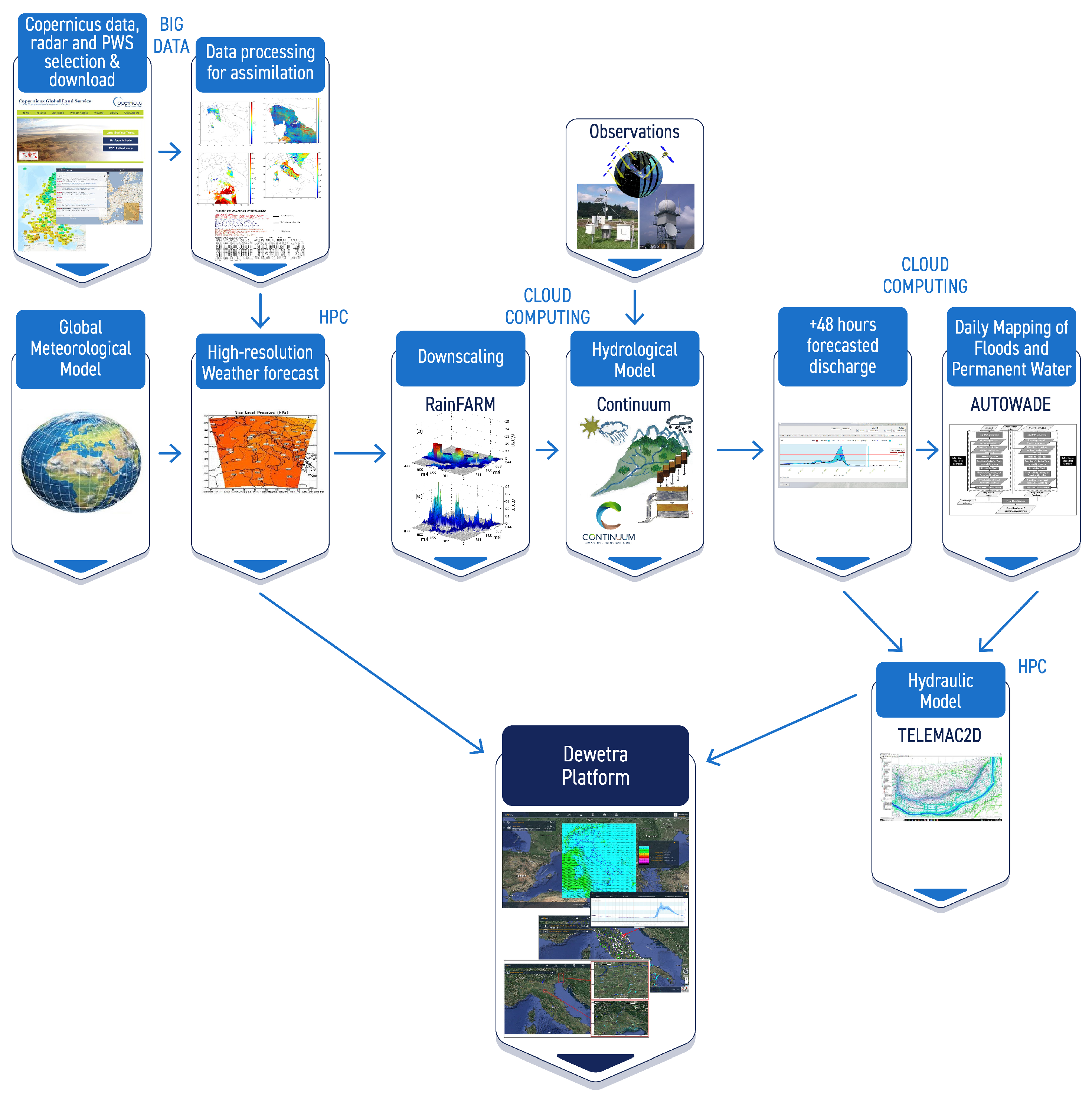
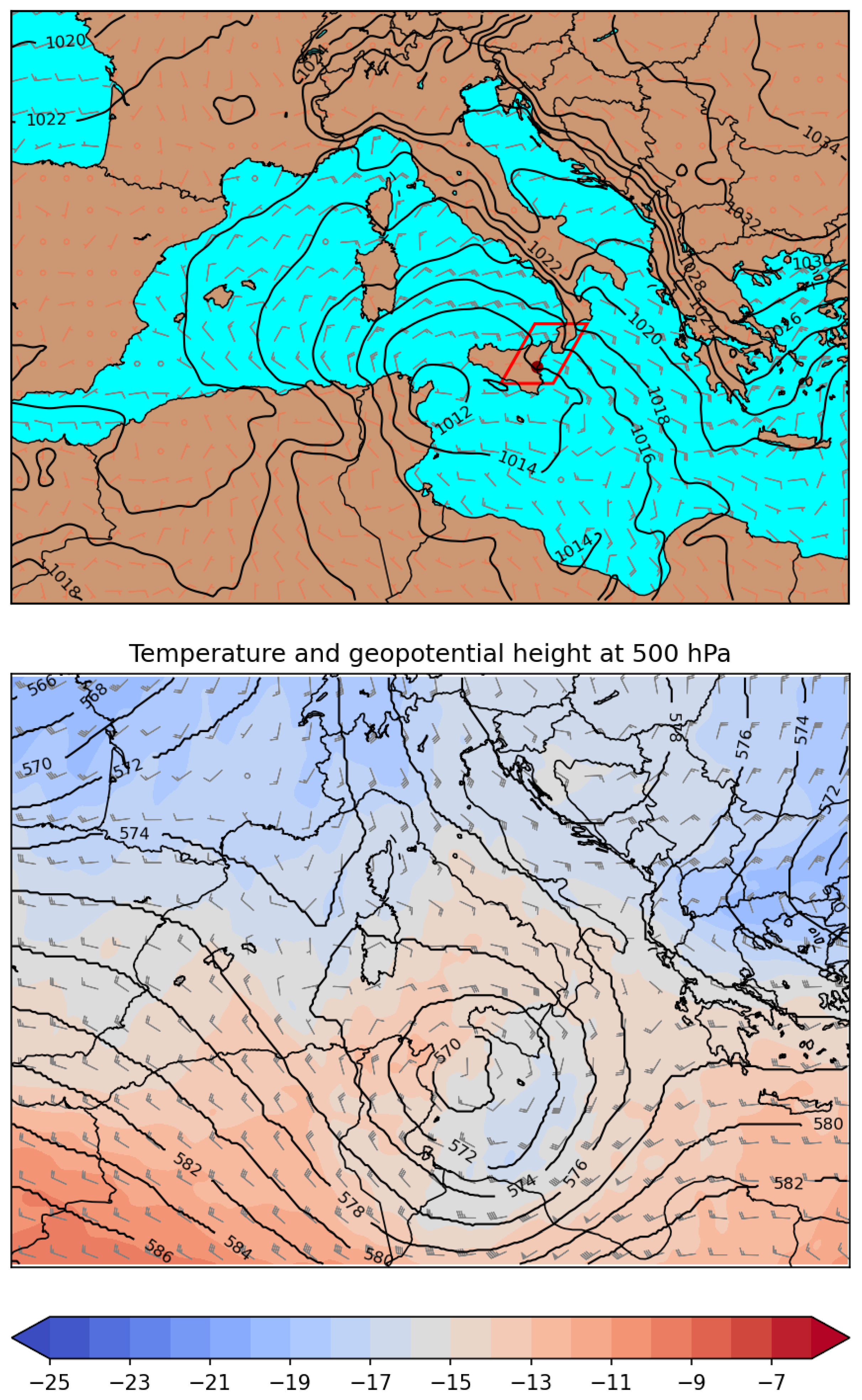
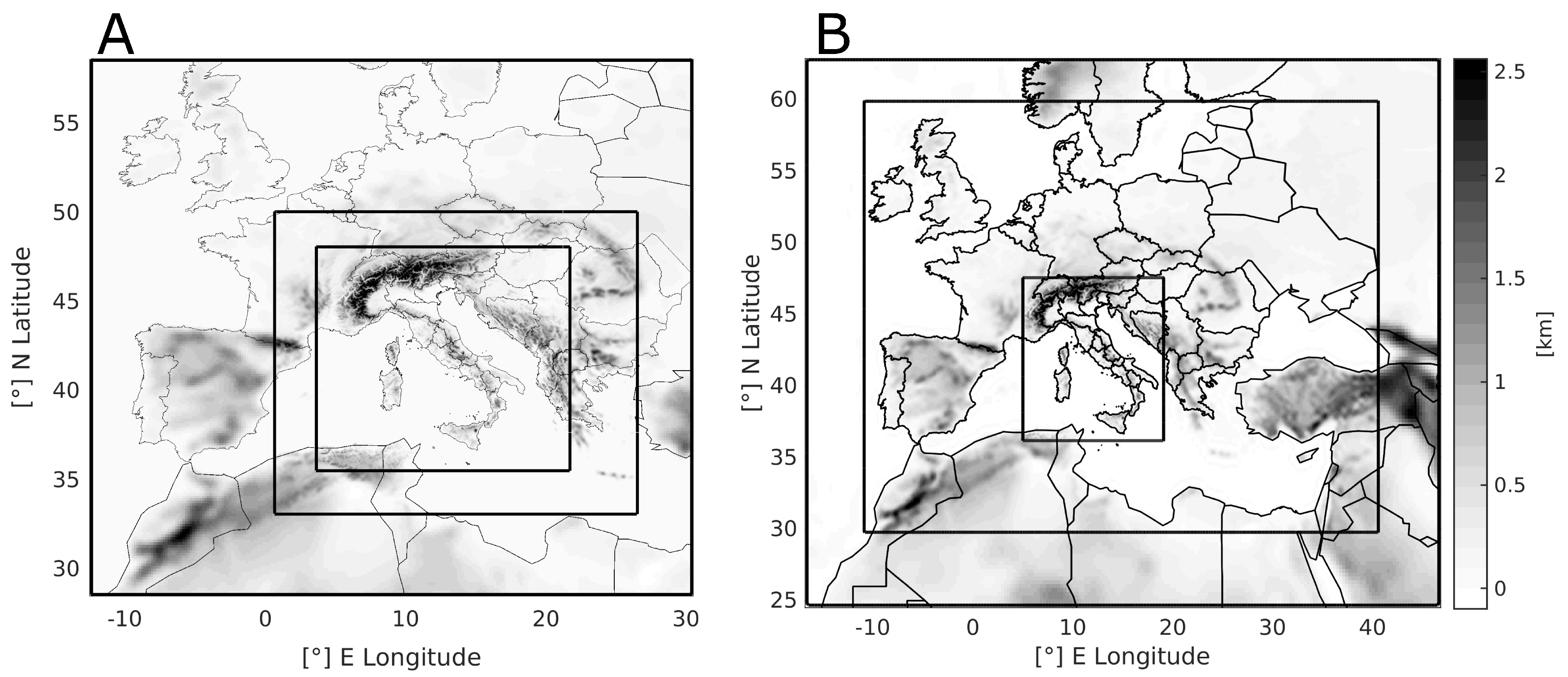
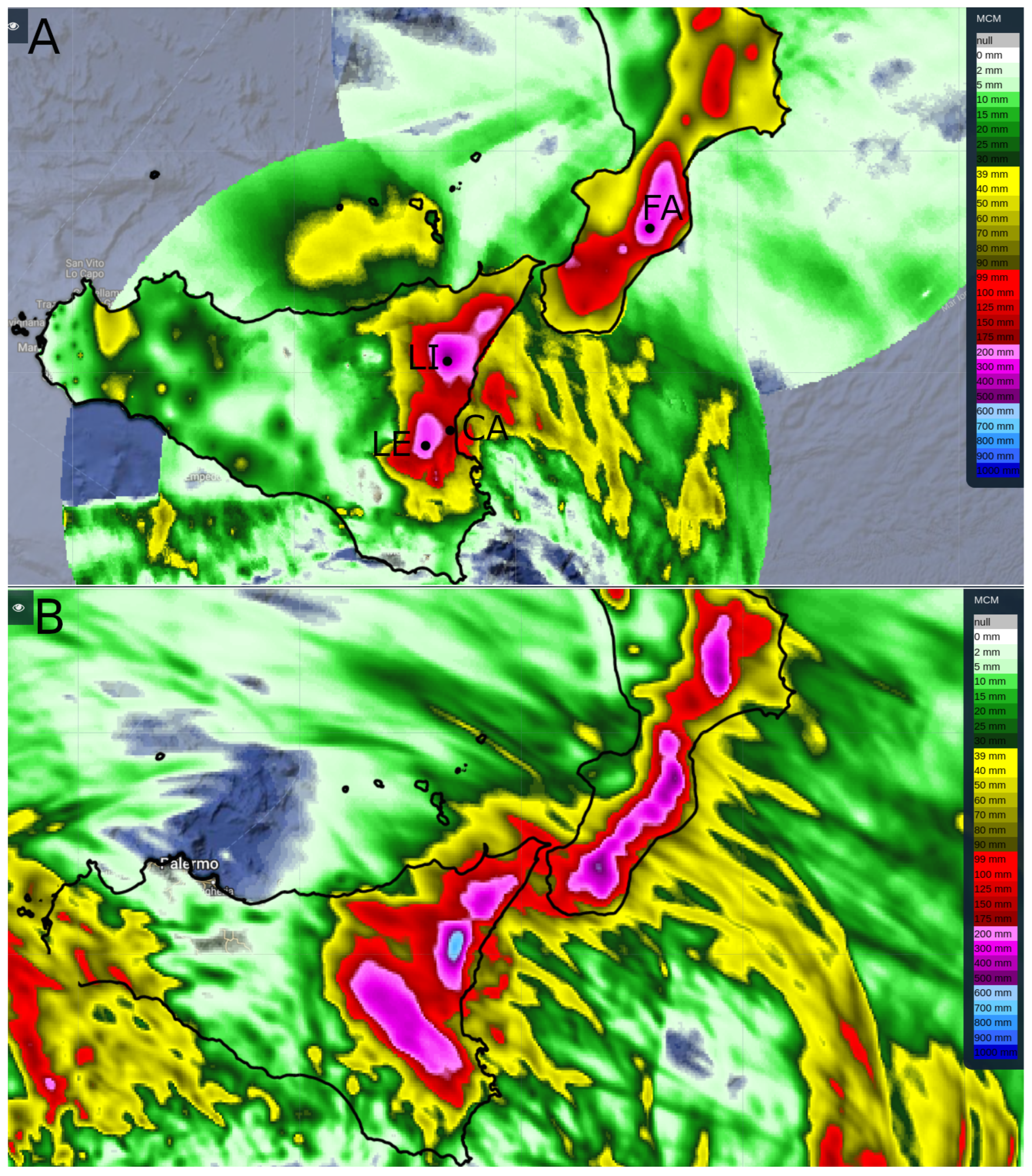
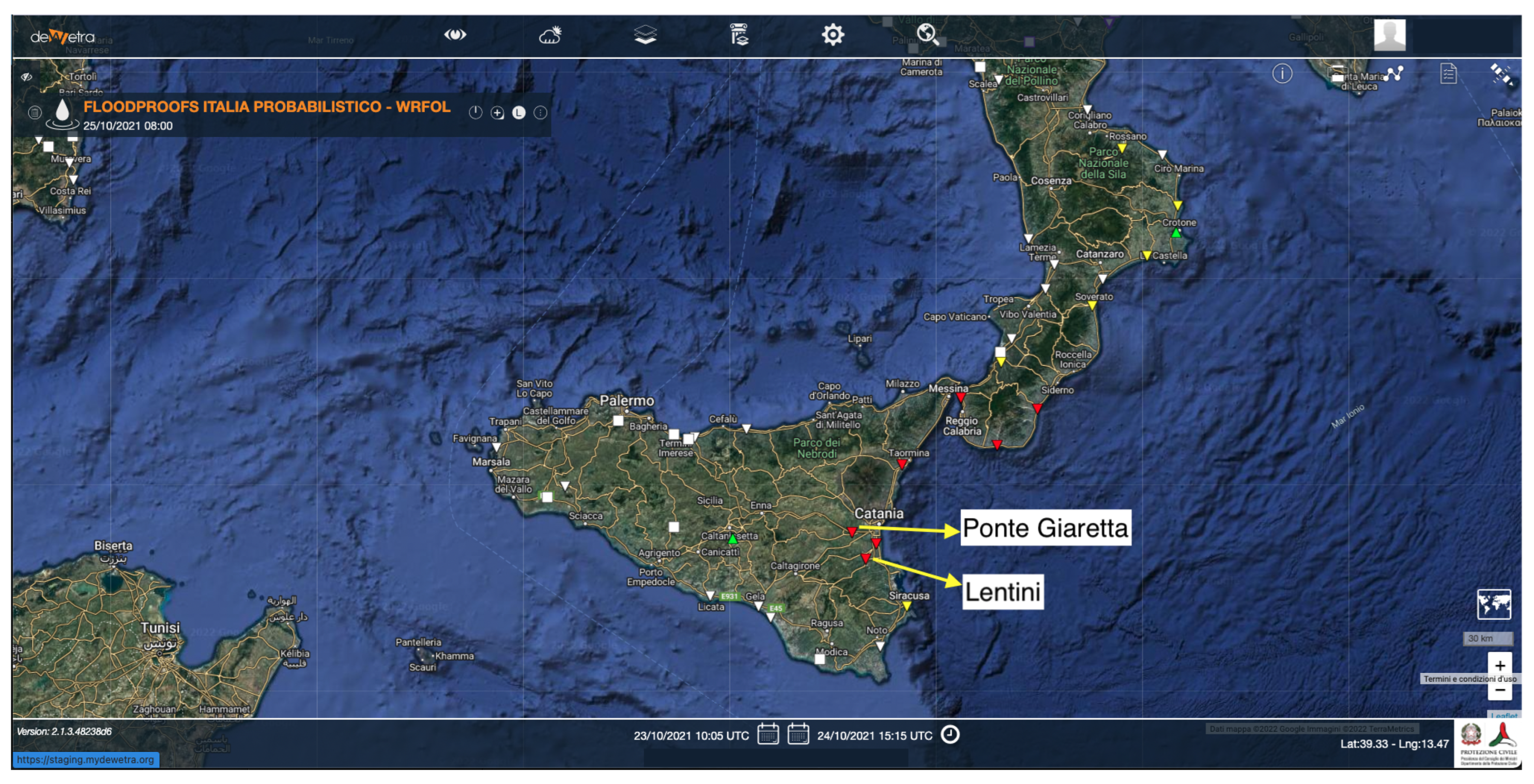
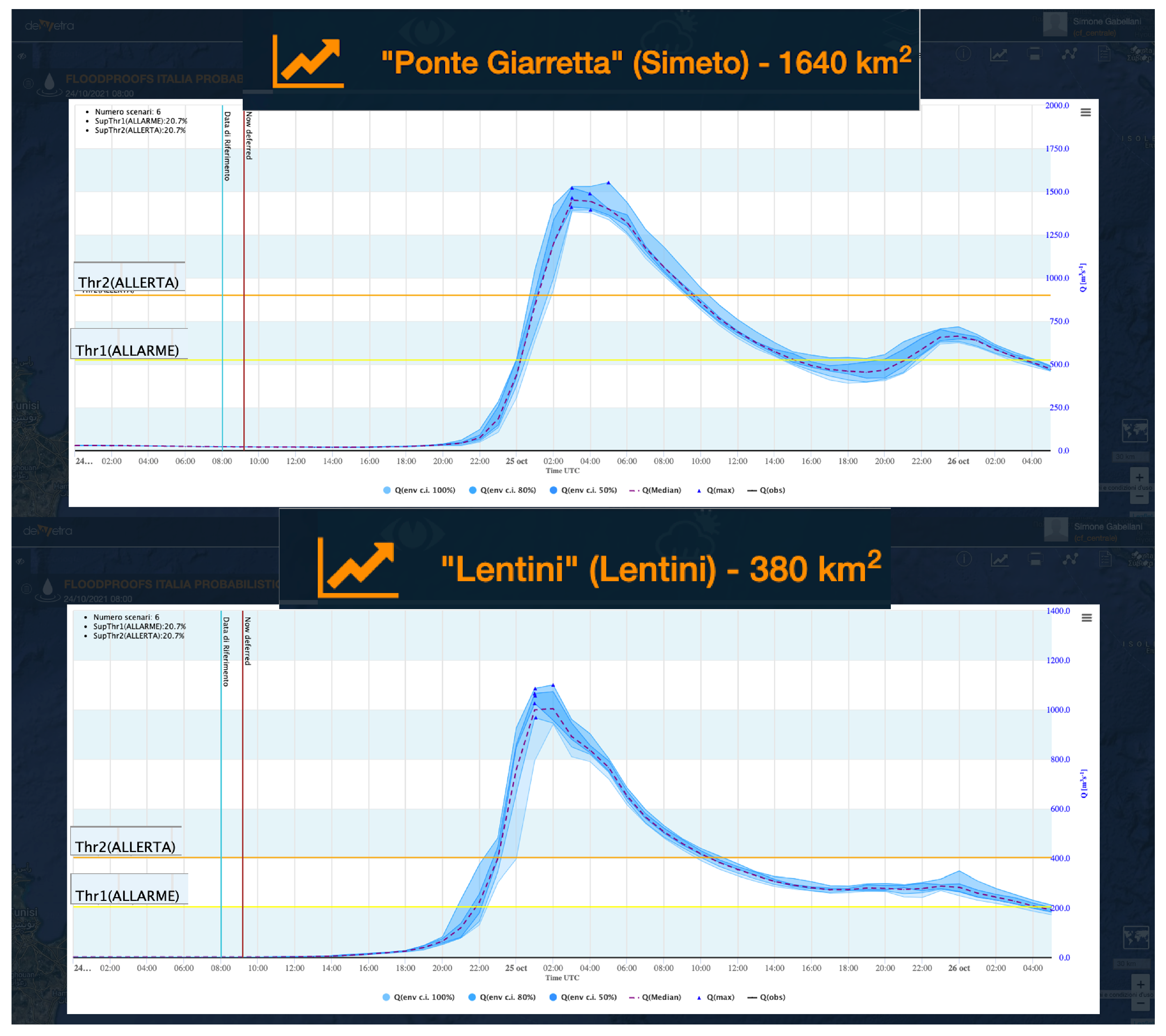
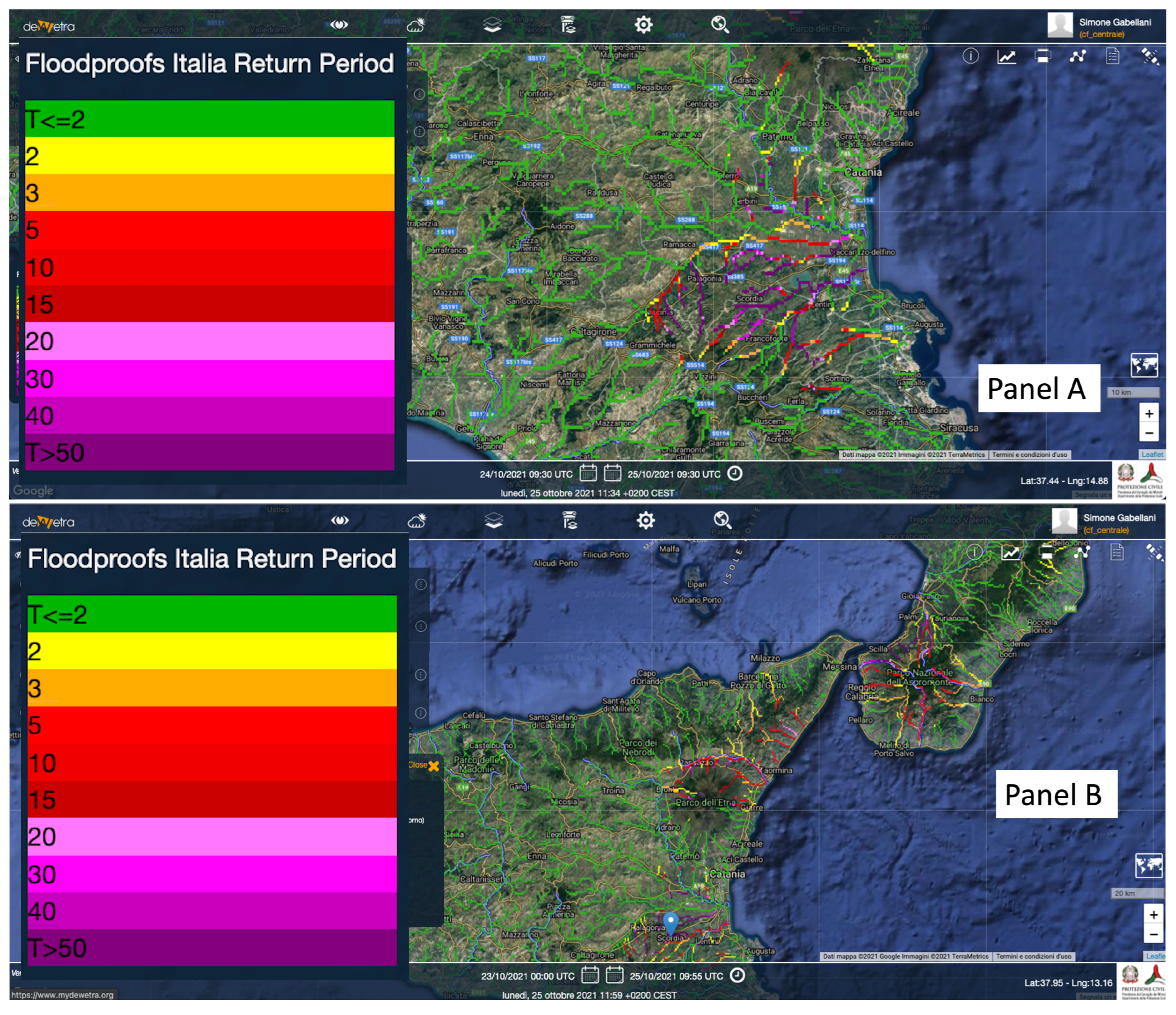
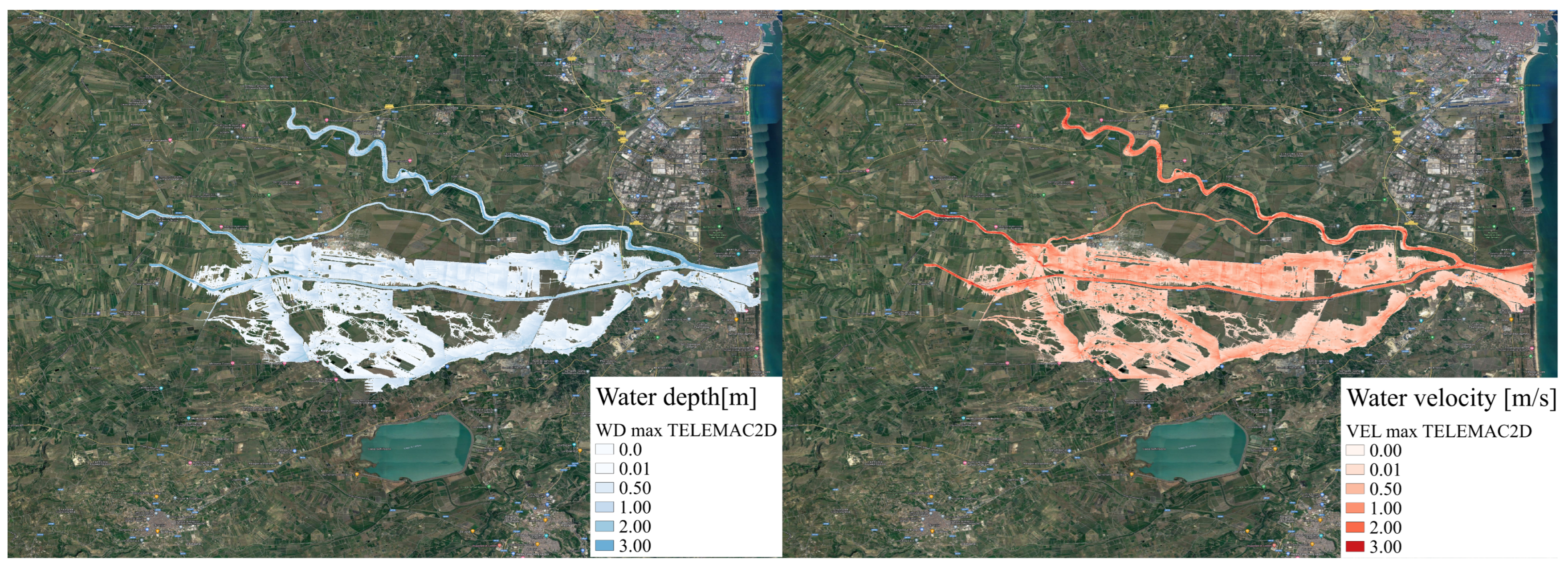
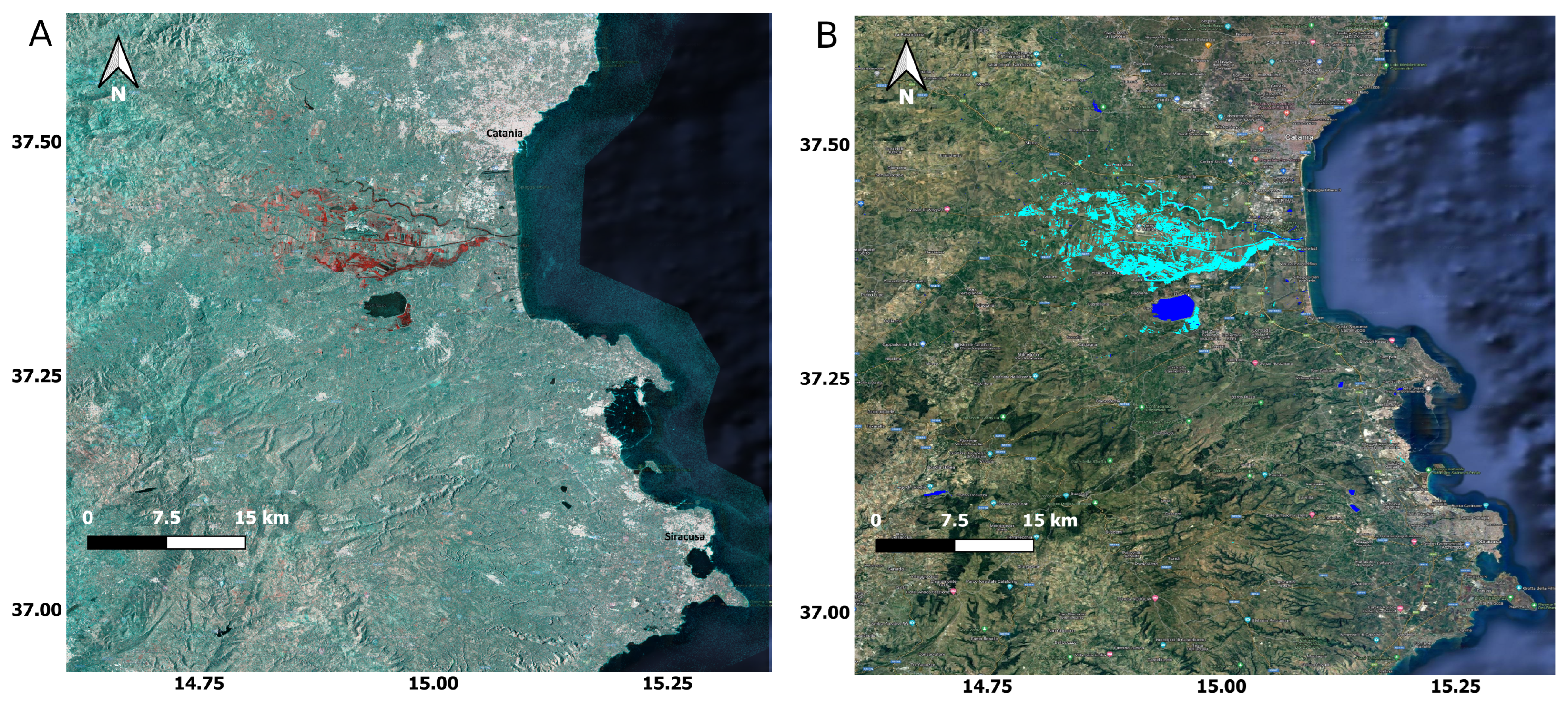
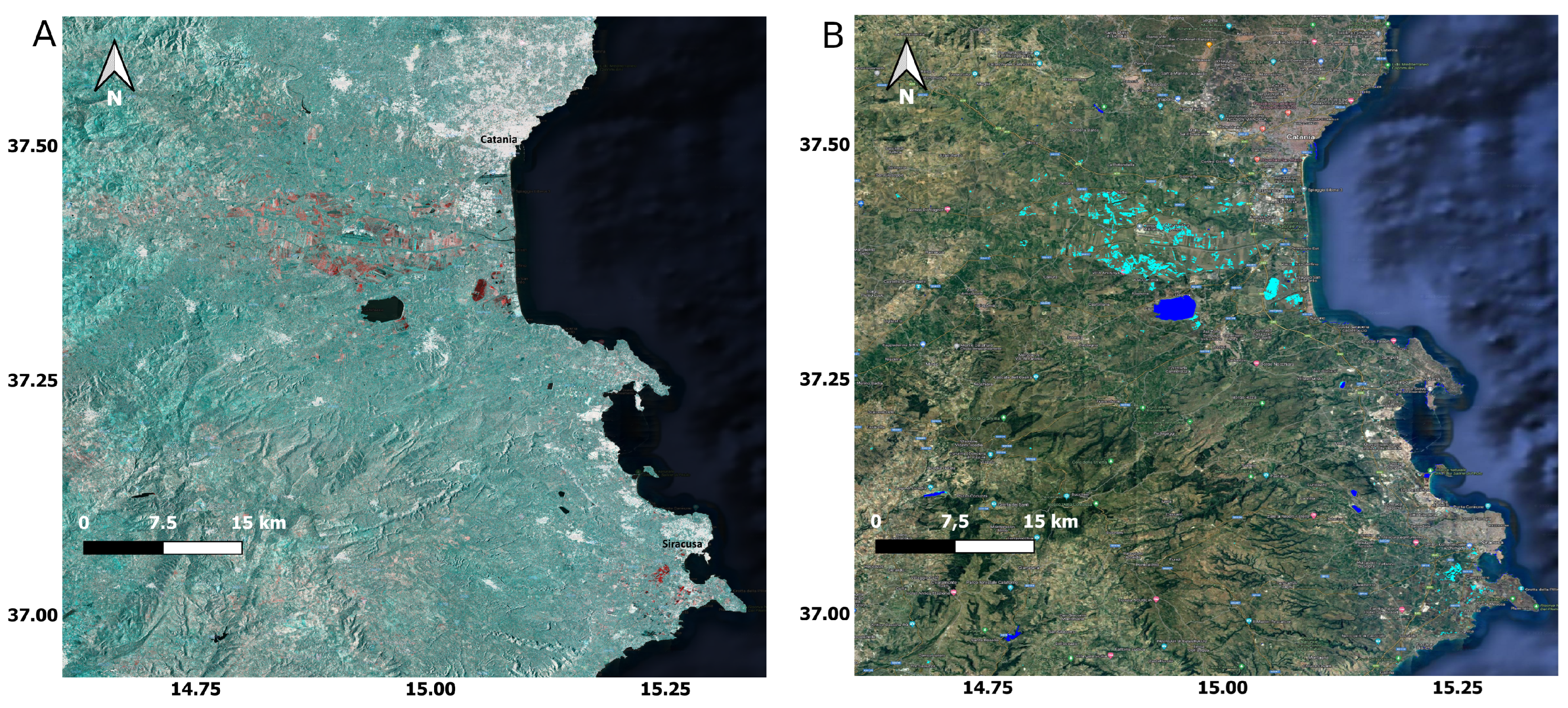
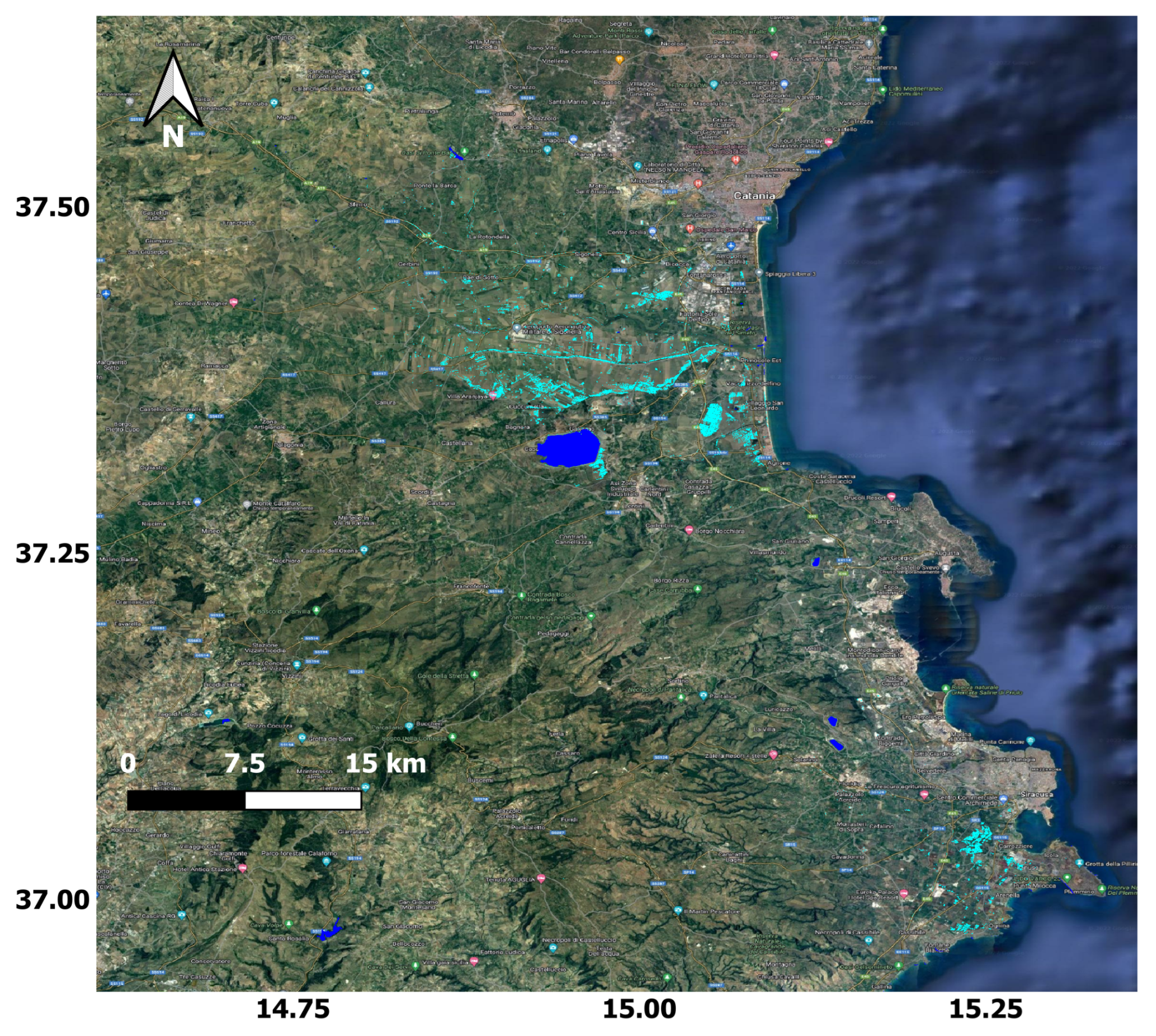
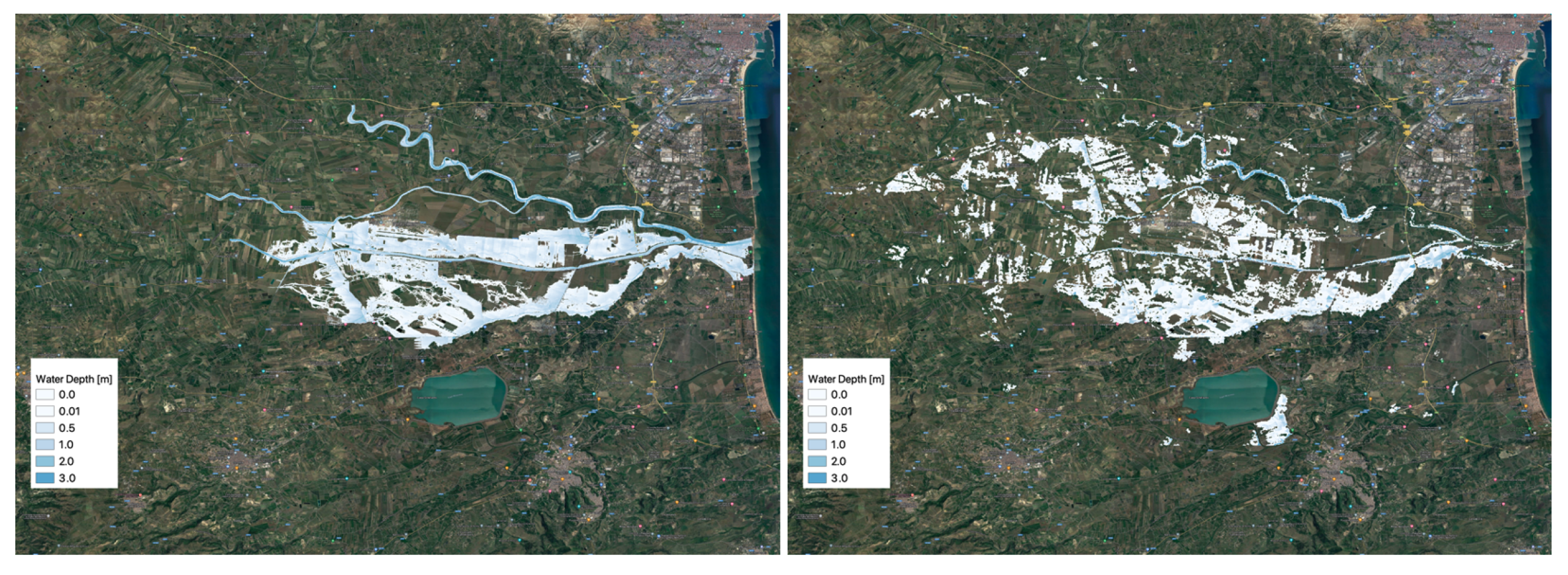
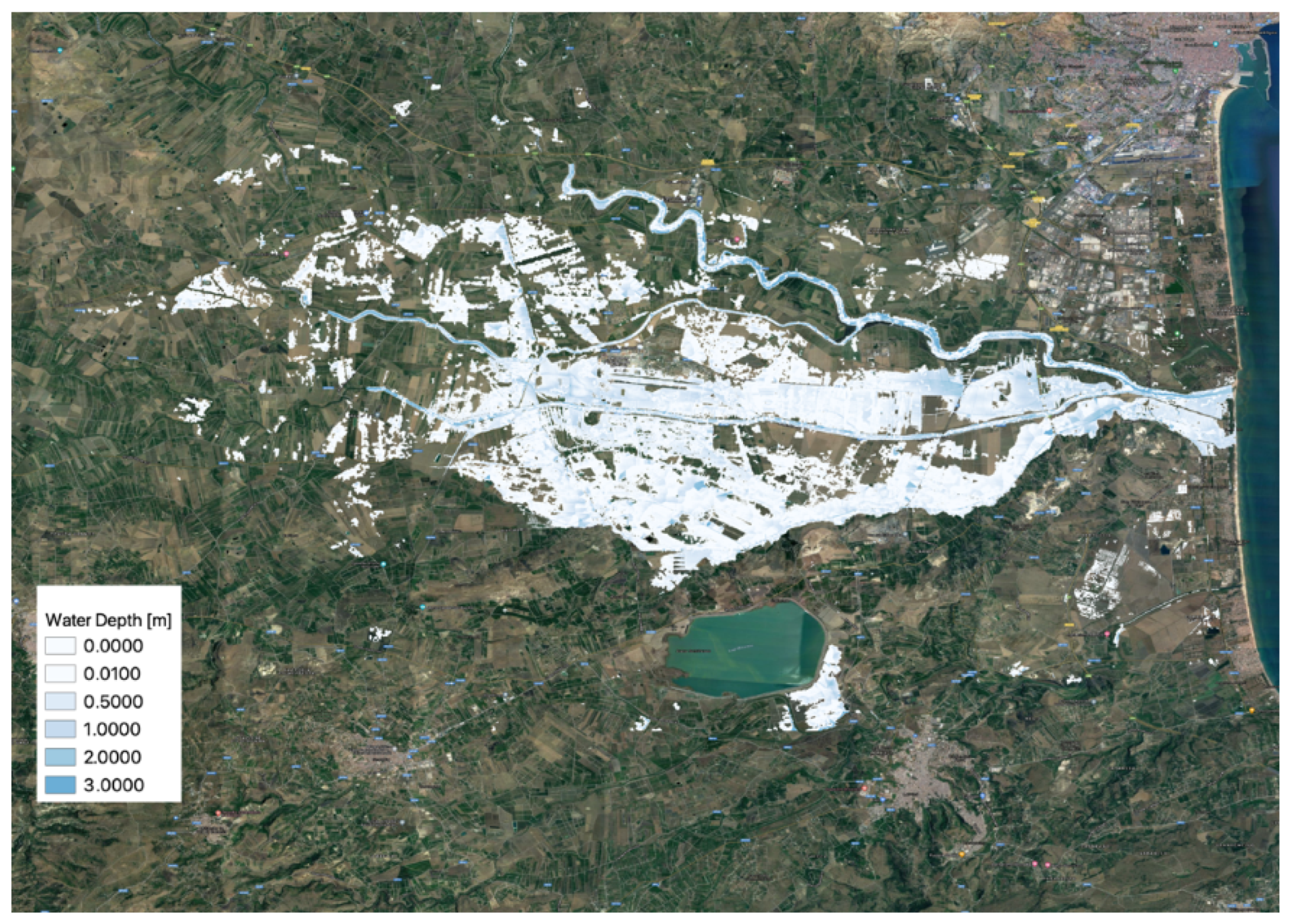
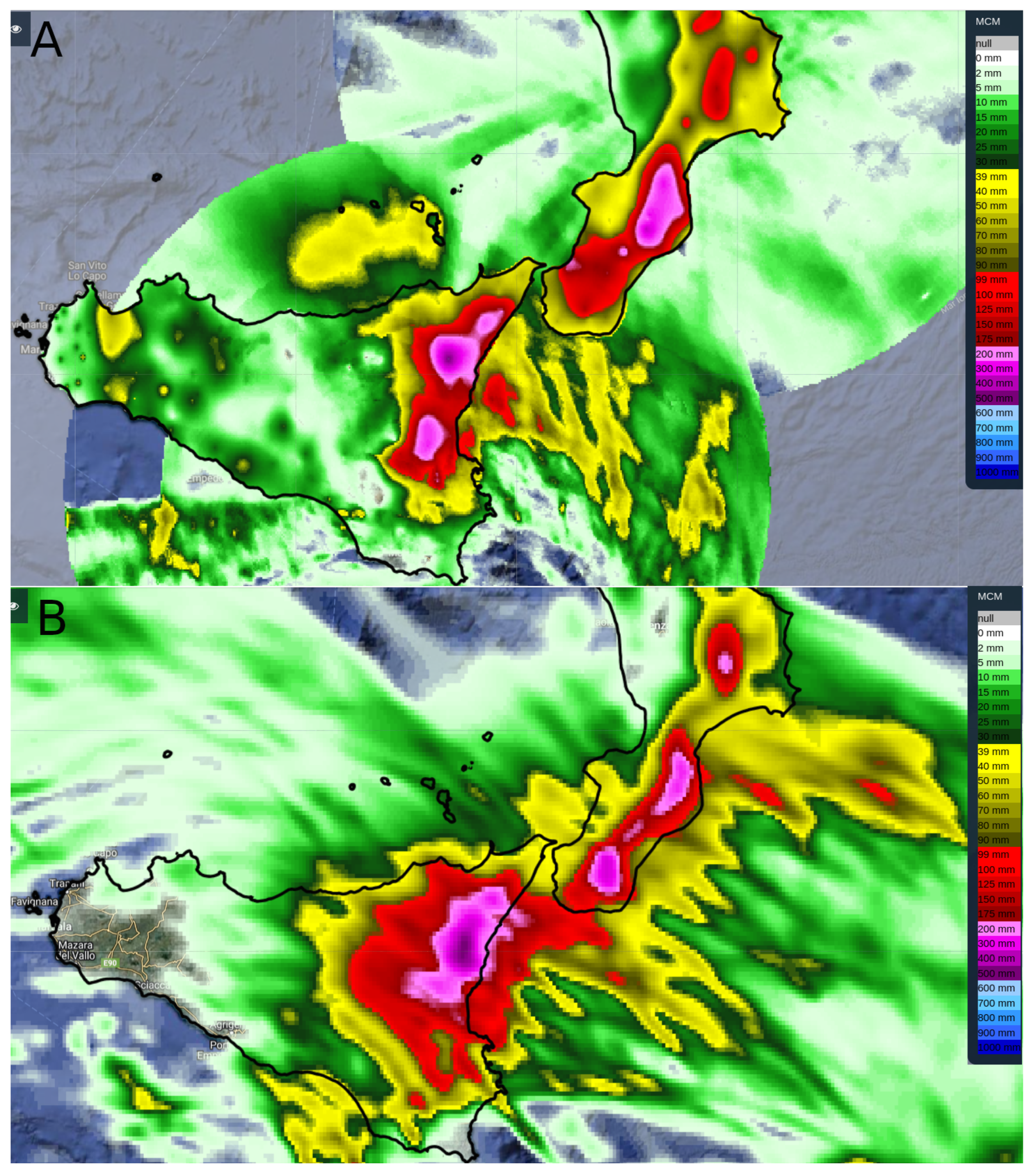
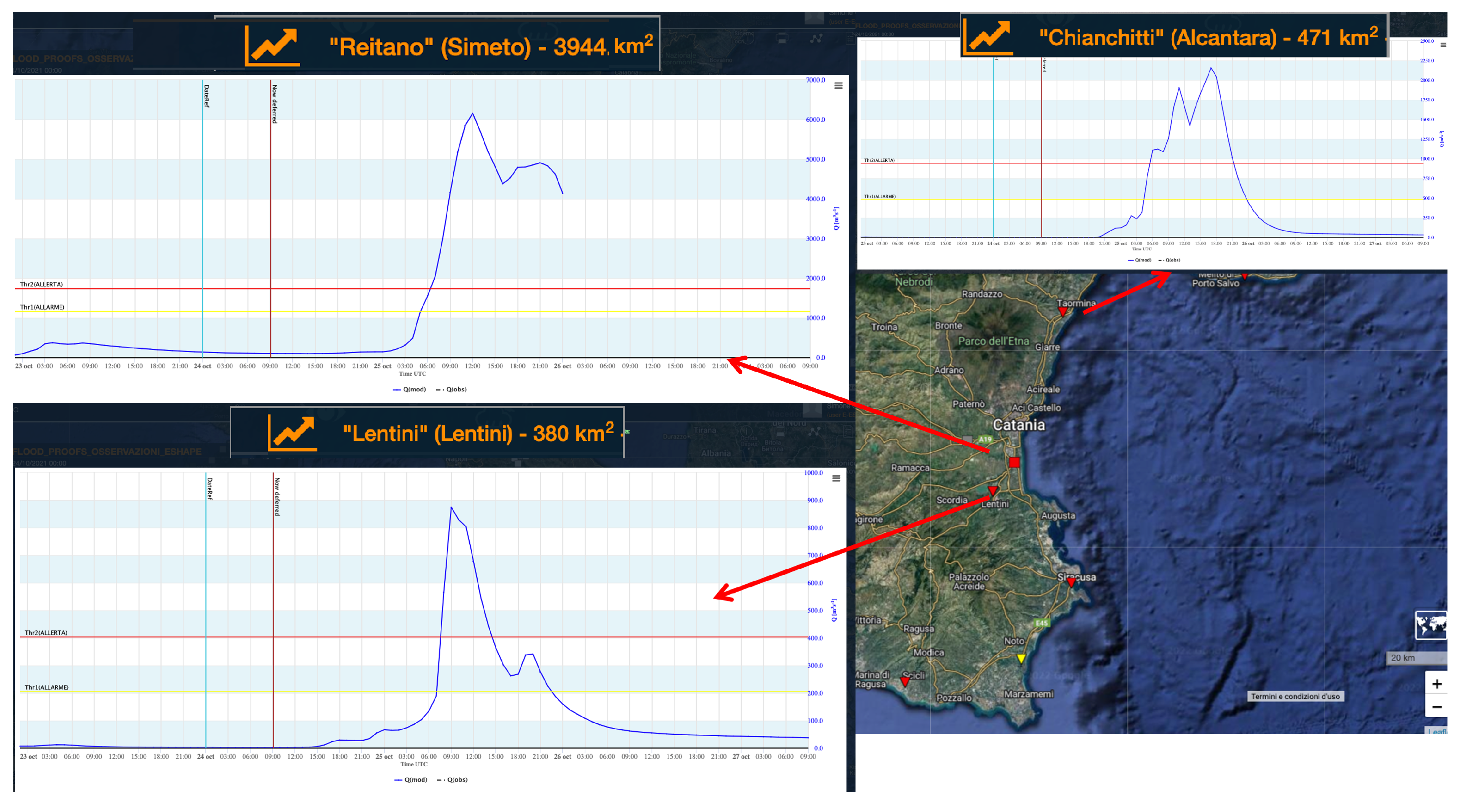

| Physics Options | WRF-OL | WRF-DA |
|---|---|---|
| Microphysics | WSM6 | WSM6 |
| PBL | YSU | YSU |
| Longwave radiation | RRTMG | RRTMG |
| Shortwave radiation | RRTMG | RRTMG |
| Land surface physics | RUC | RUC |
| Cumulus parameterization | Explicit on inner domain | Explicit on inner domain |
| CEN DIST | ANG DIFF | FCST AREA | OBS AREA | INTERS AREA | UNION AREA | SYMM DIFF | FCST INT50 | OBS INT50 | FCST INT90 | OBS INT90 | TOT INT | |
|---|---|---|---|---|---|---|---|---|---|---|---|---|
| 150 mm | 3.41 | 3.12 | 1943 | 715 | 570 | 1638 | 1086 | 228 | 194 | 360 | 275 | 0.95 |
| 200 mm | 12.49 | 7.33 | 941 | 240 | 199 | 982 | 783 | 274 | 248 | 398 | 334 | 0.91 |
| CEN DIST | ANG DIFF | FCST AREA | OBS AREA | INTERS AREA | UNION AREA | SYMM DIFF | FCST INT50 | OBS INT50 | FCST INT90 | OBS INT90 | TOT INT | |
|---|---|---|---|---|---|---|---|---|---|---|---|---|
| 150 mm | 12.6 | 3.04 | 1251 | 715 | 580 | 1386 | 806 | 196 | 194 | 364 | 275 | 0.97 |
| 200 mm | 16.3 | 0.29 | 579 | 240 | 185 | 634 | 449 | 266 | 248 | 483 | 334 | 0.95 |
| Threshold Criticality | Benchmark | WRF-DA | WRF-OL Prob. | |||
|---|---|---|---|---|---|---|
| Basin | Section | Qpeak [m3/s] | Qpeak [m3/s] | Qpeak [m3/s] | QpeakMin [m3/s] | QpeakMax [m3/s] |
| Lentini | Lentini | 403 | 767 | 532 | 968 | 1100 |
| Anapo | Siracusa | 467 | 85 | 507 | 297 | 331 |
| Simeto | Reitano | 1742 | 1492 | 4093 | 5200 | 5600 |
| Alcantara | Chianchitti | 942 | 1340 | 1467 | 1049 | 1446 |
| Catona | Reggio Calabria | 83 | 98 | 137 | 54 | 97 |
| Amendola | Calimara | 330 | 267 | 796 | 294 | 401 |
| Petrace | Rizziconi | 756 | 620 | 709 | 428 | 556 |
| Bonamico | Casignana | 349 | 255 | 756 | 353 | 542 |
Publisher’s Note: MDPI stays neutral with regard to jurisdictional claims in published maps and institutional affiliations. |
© 2022 by the authors. Licensee MDPI, Basel, Switzerland. This article is an open access article distributed under the terms and conditions of the Creative Commons Attribution (CC BY) license (https://creativecommons.org/licenses/by/4.0/).
Share and Cite
Lagasio, M.; Fagugli, G.; Ferraris, L.; Fiori, E.; Gabellani, S.; Masi, R.; Mazzarella, V.; Milelli, M.; Parodi, A.; Pignone, F.; et al. A Complete Meteo/Hydro/Hydraulic Chain Application to Support Early Warning and Monitoring Systems: The Apollo Medicane Use Case. Remote Sens. 2022, 14, 6348. https://doi.org/10.3390/rs14246348
Lagasio M, Fagugli G, Ferraris L, Fiori E, Gabellani S, Masi R, Mazzarella V, Milelli M, Parodi A, Pignone F, et al. A Complete Meteo/Hydro/Hydraulic Chain Application to Support Early Warning and Monitoring Systems: The Apollo Medicane Use Case. Remote Sensing. 2022; 14(24):6348. https://doi.org/10.3390/rs14246348
Chicago/Turabian StyleLagasio, Martina, Giacomo Fagugli, Luca Ferraris, Elisabetta Fiori, Simone Gabellani, Rocco Masi, Vincenzo Mazzarella, Massimo Milelli, Andrea Parodi, Flavio Pignone, and et al. 2022. "A Complete Meteo/Hydro/Hydraulic Chain Application to Support Early Warning and Monitoring Systems: The Apollo Medicane Use Case" Remote Sensing 14, no. 24: 6348. https://doi.org/10.3390/rs14246348
APA StyleLagasio, M., Fagugli, G., Ferraris, L., Fiori, E., Gabellani, S., Masi, R., Mazzarella, V., Milelli, M., Parodi, A., Pignone, F., Puca, S., Pulvirenti, L., Silvestro, F., Squicciarino, G., & Parodi, A. (2022). A Complete Meteo/Hydro/Hydraulic Chain Application to Support Early Warning and Monitoring Systems: The Apollo Medicane Use Case. Remote Sensing, 14(24), 6348. https://doi.org/10.3390/rs14246348








